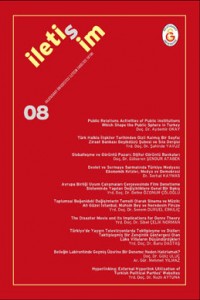Abstract
The purpose of this work is to study new forms of political behavior developed by the Internet over the persuasion process preceding the Turkish General Elections in 2007. The analysis is based on external hyperlink connections as indicated on the Turkish political parties' websites. This study defines an external link as a new strategy for structuring political communication. Through hyperlinks analysis, the study interrogates the strategic character of the Web structure. As a navigation element, the external link permits creating connections between different actors by exposing a strategic choice, which reflects a political behavior to create certain network connectivity. The questions in focus are: What types of actors are involved in the environment of a website? Which political and social associations are created on political parties' websites during campaign periods?
References
- ADAMIC, L. A., ADAR, E. (2001, May 1-5). You are what you link. Paper presented at the 10th International World Wide Web Conference. Available online: http://www10.org/program/society/yawyl/YouAreWhatYouLink.html BURBULES, N. C., CALLISTER, T. A. (2000). Watch IT: The risks and promises of information technologies for education, Boulder, CO: Westview Press. FOOT, K.A., SCHNEIDER, S.M., DOUGHERTY, M., XENOS, M. and LARSEN, E. (2003) Analyzing Linking Practices: Candidate Sites in the 2002 U.S. Electoral Web Sphere, Journal of Computer-mediated Communication 8(4). Available online: http://www.ascusc.org/jcmc/vol8/issue4/foot.html HALAVAIS, A., GARRIDO, M. (2003). Mapping networks of support for the Zapatista movement, In McCaughy, M., & Ayers, M. D. (Eds.), Cyberactivism: Online activism in theory and practice. London, Routledge. HALAVAIS, A. (2000). National borders on the World Wide Web, New Media & Society, 2(1), 7-28. HINE, C. (2000). Virtual ethnography, Thousand Oaks, CA: Sage. JACKSON, M. (1997). Assessing the structure of the communication on the World Wide Web, Journal of Computer-Mediated Communication, 3(1). Available online: http://www.ascusc.org/jcmc/vol3/issue1/jackson.html. KAMALI, N., LOKER, S.(2002). Mass Customization: on-line consumer involvement in product design, Journal of Computer-Mediated Communication 7(4), Available online: http://jcmc.indiana.edu/vol7/issue4/loker.html 8möK+LEINBERG, J. (1999): Authorative sources in a hyperlinked environment, Journal of ACM 46(5)*wwww
Abstract
L'objectif de ce travail est d'étudier les nouvelles formes de comportement politique développées par Internet pendant les élections générales turques en 2007. L'analyse est basée sur l'étude des réseaux des hyperliens externes formées entre les sites Web des partis politiques. L'hyperlien externe est considéré dans cette étude comme une nouvelle stratégie pour structurer la communication politique. L'analyse des hyperliens, permets à éxaminer le caractère stratégique de la structure du Web. Autrement dit, ils permettent de créer des connections entre différents acteurs en exposant un choix stratégique, qui reflète le comportement politique pour créer le réseau. Les questions du travail sont : Quels types d'acteurs sont impliqués dans l'environnement des sites Web des partis politiques? Quelles associations politiques et sociales sont créées par ces sites Web pendant des périodes de campagne électorale?
References
- ADAMIC, L. A., ADAR, E. (2001, May 1-5). You are what you link. Paper presented at the 10th International World Wide Web Conference. Available online: http://www10.org/program/society/yawyl/YouAreWhatYouLink.html BURBULES, N. C., CALLISTER, T. A. (2000). Watch IT: The risks and promises of information technologies for education, Boulder, CO: Westview Press. FOOT, K.A., SCHNEIDER, S.M., DOUGHERTY, M., XENOS, M. and LARSEN, E. (2003) Analyzing Linking Practices: Candidate Sites in the 2002 U.S. Electoral Web Sphere, Journal of Computer-mediated Communication 8(4). Available online: http://www.ascusc.org/jcmc/vol8/issue4/foot.html HALAVAIS, A., GARRIDO, M. (2003). Mapping networks of support for the Zapatista movement, In McCaughy, M., & Ayers, M. D. (Eds.), Cyberactivism: Online activism in theory and practice. London, Routledge. HALAVAIS, A. (2000). National borders on the World Wide Web, New Media & Society, 2(1), 7-28. HINE, C. (2000). Virtual ethnography, Thousand Oaks, CA: Sage. JACKSON, M. (1997). Assessing the structure of the communication on the World Wide Web, Journal of Computer-Mediated Communication, 3(1). Available online: http://www.ascusc.org/jcmc/vol3/issue1/jackson.html. KAMALI, N., LOKER, S.(2002). Mass Customization: on-line consumer involvement in product design, Journal of Computer-Mediated Communication 7(4), Available online: http://jcmc.indiana.edu/vol7/issue4/loker.html 8möK+LEINBERG, J. (1999): Authorative sources in a hyperlinked environment, Journal of ACM 46(5)*wwww
Abstract
Bu çalışmada, 2007 Türkiye Genel Seçimleri ortamında Internet kullanımına bağlı olarak oluşan yeni siyasal davranış biçimlerinin sorgulanması hedeflenmektedir. Siyasi iletişim yapılarını çözümlemek için Link Ağları Analizi araştırma metodu olarak kullanılmaktadır. Bu genel çerçevede, Türk siyasal parti web sitelerinin dış link bağlantılarının incelenmesi temel araştırma alanı olarak belirlenmiştir. İkna süreçlerinde, link bağlantılarıyla ağ oluşturulmasının stratejik bir anlam ürettiği ve siyasal tutuma bağlı olarak ikna sürecinde bir iletişim tercihini gösterdiği varsayımından hareketle sorgulama gerçekleştirilmektedir: Siyasi partilerin web sayfalarına hangi aktörler dahil ediliyor? Seçim kampanyası döneminde dış linkler aracılığıyla hangi politik ve sosyal özdeşleştirmeler parti web sitelerinde oluşturuluyor?
Keywords
References
- ADAMIC, L. A., ADAR, E. (2001, May 1-5). You are what you link. Paper presented at the 10th International World Wide Web Conference. Available online: http://www10.org/program/society/yawyl/YouAreWhatYouLink.html BURBULES, N. C., CALLISTER, T. A. (2000). Watch IT: The risks and promises of information technologies for education, Boulder, CO: Westview Press. FOOT, K.A., SCHNEIDER, S.M., DOUGHERTY, M., XENOS, M. and LARSEN, E. (2003) Analyzing Linking Practices: Candidate Sites in the 2002 U.S. Electoral Web Sphere, Journal of Computer-mediated Communication 8(4). Available online: http://www.ascusc.org/jcmc/vol8/issue4/foot.html HALAVAIS, A., GARRIDO, M. (2003). Mapping networks of support for the Zapatista movement, In McCaughy, M., & Ayers, M. D. (Eds.), Cyberactivism: Online activism in theory and practice. London, Routledge. HALAVAIS, A. (2000). National borders on the World Wide Web, New Media & Society, 2(1), 7-28. HINE, C. (2000). Virtual ethnography, Thousand Oaks, CA: Sage. JACKSON, M. (1997). Assessing the structure of the communication on the World Wide Web, Journal of Computer-Mediated Communication, 3(1). Available online: http://www.ascusc.org/jcmc/vol3/issue1/jackson.html. KAMALI, N., LOKER, S.(2002). Mass Customization: on-line consumer involvement in product design, Journal of Computer-Mediated Communication 7(4), Available online: http://jcmc.indiana.edu/vol7/issue4/loker.html 8möK+LEINBERG, J. (1999): Authorative sources in a hyperlinked environment, Journal of ACM 46(5)*wwww
Details
| Primary Language | Turkish |
|---|---|
| Authors | |
| Publication Date | February 1, 2008 |
| Published in Issue | Year 2008 Issue: 8 |



